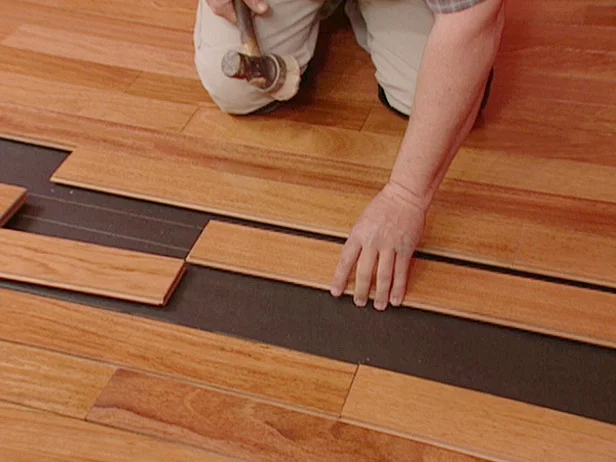Hardwood flooring transforms any space with its natural beauty and lasting value. However, achieving professional results depends heavily on choosing the right installation method for your specific subfloor conditions. Whether you're planning a DIY project or working with professionals, understanding these installation techniques will help ensure your hardwood floors look stunning and perform well for decades to come.
The installation method you select directly impacts your floor's stability, longevity, and overall performance. Different subfloor types like plywood, concrete, and radiant heating systems, each present unique challenges and opportunities. Making the right choice from the start prevents costly repairs and ensures your investment delivers maximum returns.
Understanding Hardwood Flooring Types
Before diving into installation methods, it's essential to understand the two main categories of hardwood flooring, as each works better with certain installation techniques.
Solid Hardwood consists of planks cut from single pieces of wood, typically ¾-inch thick. This traditional option offers excellent durability and can be refinished multiple times throughout its lifespan. Solid hardwood requires nail-down installation and works best over plywood subfloors.
Engineered Hardwood features a real wood veneer bonded to multiple layers of plywood or high-density fiberboard. This construction makes it more stable and moisture-resistant than solid hardwood. Engineered flooring accommodates various installation methods, including glue-down and floating installations, making it suitable for concrete subfloors and radiant heating systems.
Subfloor Considerations for Installation Success
Your subfloor type determines which installation methods will work effectively and which should be avoided entirely.
Plywood Subfloors
Plywood remains the gold standard for hardwood installation. Its stable surface accepts nails and staples securely while providing excellent support. Most installation methods work well over properly prepared plywood subfloors.
Concrete Subfloors
Concrete presents unique challenges, primarily moisture concerns and the inability to use nail-down methods. Proper moisture testing and vapor barriers become critical for successful installations over concrete.
Radiant Heating Systems
Radiant heat systems create temperature fluctuations that cause wood expansion and contraction. Installation methods must accommodate this movement to prevent gaps, buckling, and other issues.
Installation Methods for Plywood Subfloors
Plywood's versatility allows for multiple installation approaches, each with distinct advantages.
Nail Down Installation
This traditional method involves securing solid hardwood planks directly to the plywood using a pneumatic flooring nailer. The nailer drives nails at precise angles through the tongue of each plank, creating invisible fastening points.
Nail-down installation provides exceptional stability and works particularly well with thicker solid hardwood planks. The mechanical fastening creates a permanent bond that can withstand heavy foot traffic and furniture loads. This method requires ¾-inch solid hardwood and works best when the plywood subfloor is at least ¾-inch thick.
Staple Down Installation
Similar to nail-down installation, staple-down uses pneumatic staplers instead of nailers. Staples provide secure fastening while offering slightly more flexibility than nails, which can help accommodate minor wood movement.
This method costs less than nail-down installation and installs faster in many cases. Staples work well with both solid and engineered hardwood, though thicker planks generally perform better with this fastening method.
Glue Down Installation
Glue-down installation bonds engineered hardwood directly to the plywood using specially formulated adhesives. The adhesive spreads evenly across the subfloor, creating continuous contact between the flooring and substrate.
This method provides excellent stability and helps reduce squeaking and hollow sounds. Glue-down installation also offers superior sound dampening compared to mechanical fastening methods. The continuous bond distributes loads evenly, making it ideal for high-traffic areas.
Floating Installation
Floating installation connects engineered hardwood planks to each other without attaching them to the subfloor. Click-lock or tongue-and-groove connections create a unified floating surface over an underlayment pad.
This method installs quickly and accommodates wood movement effectively. Floating floors can be removed and reinstalled if necessary, making them ideal for temporary installations or areas where access to utilities might be needed. The underlayment provides cushioning and sound reduction benefits.
Installation Methods for Concrete Subfloors
Concrete subfloors require specialized approaches to address moisture concerns and create stable surfaces for hardwood installation.
Glue Down Installation
Glue-down remains the most popular method for installing engineered hardwood over concrete. Moisture-resistant adhesives create strong bonds while accommodating the slight moisture transmission typical of concrete subfloors.
Proper surface preparation becomes critical for glue-down success. The concrete must be level, clean, and dry before adhesive application. Moisture testing should confirm levels below manufacturer specifications, typically 4% or less for wood flooring installations.
Floating Installation
Floating installations over concrete require vapor barriers and quality underlayments to prevent moisture problems. The floating system allows for wood movement while protecting the flooring from concrete moisture transmission.
This method offers faster installation and easier repairs if moisture issues develop later. The vapor barrier and underlayment combination creates an effective moisture management system when properly installed.
Installation Methods for Radiant Heating Systems
Radiant heating creates unique challenges that require careful consideration during installation planning.
Floating Installation for Radiant Systems
Floating installation works best over radiant heating systems because it allows the wood to expand and contract freely with temperature changes. The flooring system moves as a unit over the heated subfloor rather than being locked in place.
Proper underlayment selection becomes crucial for radiant applications. The underlayment must provide thermal conductivity while offering adequate moisture protection and cushioning. Some underlayments are specifically designed for radiant heating applications.
Special Considerations for Radiant Heat
Radiant heating systems require gradual temperature changes to prevent wood movement problems. The system should be operational for several weeks before installation and gradually brought to operating temperature after installation completion.
Temperature limits typically cap at 80°F for surface temperature to prevent excessive wood movement and potential damage. Humidity control becomes even more critical in radiant heating environments to maintain stable conditions year-round.
Professional Installation vs. DIY Approaches
While some homeowners successfully install hardwood flooring themselves, professional installation ensures optimal results and protects manufacturer warranties. Complex subfloor conditions, radiant heating systems, and challenging room layouts often require professional expertise.
Creative Floors in Aurora, Illinois, brings decades of experience to hardwood installation projects throughout the Chicago area. Their craftsmen understand local climate conditions and building practices that affect flooring performance. Professional installation includes proper subfloor preparation, moisture testing, and technique selection based on your specific conditions.
Choosing the Right Method for Your Project
Several factors influence the best installation method for your hardwood flooring project. Consider your subfloor type, flooring choice, budget, timeline, and long-term performance expectations when making decisions.
Plywood subfloors offer the most flexibility, allowing nail-down, staple-down, glue-down, or floating installations. Concrete subfloors limit options to glue-down or floating methods. Radiant heating systems work best with floating installations using appropriate underlayments.
Your chosen hardwood type also influences installation options. Solid hardwood requires nail-down or staple-down methods over plywood subfloors. Engineered hardwood accommodates all installation methods, providing more flexibility for challenging subfloor conditions.
Ensuring Long-Term Success
Proper installation sets the foundation for decades of hardwood flooring enjoyment. Each installation method, when executed correctly, provides excellent performance within its intended applications. The key lies in matching the right method to your specific conditions and maintaining proper environmental controls after installation.
Regular maintenance, appropriate humidity levels, and prompt attention to any issues will maximize your hardwood flooring investment regardless of the installation method chosen. Quality installation by experienced professionals like Creative Floors ensures your new hardwood floors will provide beauty and value for years to come.
Frequently Asked Questions About Hardwood Installation
Solid hardwood flooring consists of planks made from a single piece of wood, typically ¾-inch thick. It's known for its durability and can be refinished multiple times. Engineered hardwood features a real wood veneer bonded to multiple layers of plywood, making it more stable and moisture-resistant.
The nail-down installation method is the traditional and most recommended choice for solid hardwood. It involves securing the planks directly to a plywood subfloor with a flooring nailer, creating a very stable and durable surface. This method is ideal for withstanding heavy foot traffic.
Yes, but you must use engineered hardwood. Concrete subfloors are not suitable for the nail-down method required for solid hardwood. For concrete, you can use either a glue-down or a floating installation method. It is also crucial to manage moisture with proper testing and vapor barriers.
A floating installation connects engineered hardwood planks to each other, but not to the subfloor beneath. The floor "floats" over an underlayment pad. This method is fast, allows for natural wood expansion and contraction, and is the best choice for installation over radiant heating systems.
Radiant heating causes temperature fluctuations that make wood expand and contract. A floating installation is recommended because it allows the entire floor to move as a single unit, preventing gaps and buckling. Special underlayments designed for thermal conductivity are also necessary.
While some experienced homeowners can manage a DIY installation, we recommend hiring a professional, especially for complex situations like concrete subfloors or radiant heating systems. Professionals like Creative Floors in Aurora, Illinois, ensure the subfloor is properly prepared, the correct installation method is used, and your manufacturer's warranty is protected.

